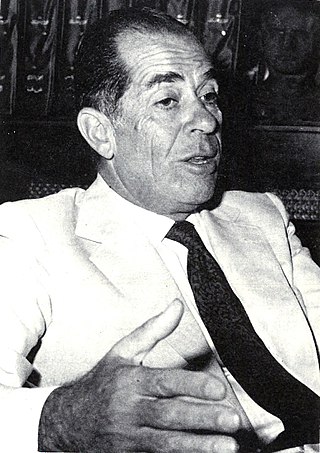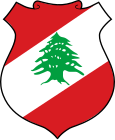
Kamal Fouad Jumblatt was a Lebanese politician who founded the Progressive Socialist Party. He led the National Movement during the Lebanese Civil War. He was a major ally of the Palestine Liberation Organization until his assassination in 1977. He authored more than 40 books centred on various political, philosophical, literary, religious, medical, social, and economic topics. In September 1972, Kamal Jumblatt received the International Lenin Peace Prize. He is the father of the Lebanese Druze leader Walid Jumblatt and the son-in-law of the Arab writer and politician Shakib Arslan.

The 1958 Lebanon crisis was a political crisis in Lebanon caused by political and religious tensions in the country that included an American military intervention, which lasted for around three months until President Camille Chamoun, who had requested the assistance, completed his term as president of Lebanon. American and Lebanese government forces occupied the Port of Beirut and Beirut International Airport. With the crisis over, the United States withdrew.

Camille Nimr Chamoun was a Lebanese politician who served as the 2nd president of Lebanon from 1952 to 1958. He was one of the country's main Christian leaders during most of the Lebanese Civil War.

Fouad Abdallah Chehab was a Lebanese general and statesman who served as president of Lebanon from 1958 to 1964. He is considered to be the founder of the Lebanese Army after Lebanon gained independence from France, and became its first commander in 1946.

The prime minister of Lebanon, officially the president of the Council of Ministers, is the head of government and the head of the Council of Ministers of Lebanon. The prime minister is appointed by the president of Lebanon, with the consent of the plurality of the members of the Parliament of Lebanon. By convention, the office holder is always a Sunni Muslim.

Élias Sarkis was a Lebanese lawyer and politician who served as the 6th president of Lebanon from 1976 to 1982.

Raymond Eddé was a Lebanese Maronite statesman who served his country for many years as a legislator and cabinet minister. He led the Lebanese National Bloc, an influential political party. The son of former President Émile Eddé, Raymond Eddé was himself a candidate for the presidency in 1958, and was proposed for the post on numerous subsequent occasions. He is remembered for having held consistent views, which he refused to compromise for the sake of political gain. His supporters called him "Lebanon's Conscience." He was a strong nationalist, who opposed the French Mandate, and later, Syrian, Israeli, and Palestinian military interventions in Lebanon.

Saeb Salam was a Lebanese politician, who served as Prime Minister six times between 1952 and 1973. Following his death, the Lebanese daily As-Safir described Salam as "most successful in dealing with the media and in presenting a particular image of himself to people on a daily basis through wearing his customary carnation ... and expounding unforgettable slogans", and that he was Lebanon's most popular prime minister after independence leader Riad Al Solh. A significant aspect of Salam was that, unlike other Lebanese leaders, he did not act as a chief over a particular area in the country. Salam fiercely advocated the unity of Lebanon.

The Presidentof the Lebanese Republic is the head of state of Lebanon. The president is elected by the parliament for a term of six years, which cannot be renewed immediately because they can only be renewed non-consecutively. By convention, the president is always a Maronite Christian who fulfills the same requirements as a candidate for the house of representatives, as per article 49 of the Lebanese constitution.

The Lebanese Communist Party is a communist party in Lebanon. It was founded in 1943 as a division of the Syrian–Lebanese Communist Party into the Syrian Communist Party and the Lebanese Communist Party; but the division was only implemented in 1964.

Adel Osseiran, also transliterated Adil 'Usayran or Adil Osseyran, was a prominent Lebanese statesman, a former Speaker of the Lebanese Parliament, and one of the founding fathers of the Lebanese Republic.
General elections were held in Lebanon on 15 April 1951, with a second round in some constituencies on 22 April. Independent candidates won the majority of seats. Voter turnout was 54.7%. The governing party, Constitutional Bloc, did not have a clear organization, so it is difficult to determine the number of its members who participated in this election. Nonetheless, the government backed three "Constutional" lists in Mount Lebanon and had 14 of their 22 candidates elected. Former Constitutionalist minister Camille Chamoun became an opposition candidate in an alliance with Kamal Jumblatt.
Voting to elect eight members of the Lebanese parliament took place in Chouf District on April 7, 1968, as part of the national general election of that year. Three of the seats of the constituency were earmarked for the Maronite community, two for the Sunni Muslim, two for the Druze whilst the last seat was allocated to the Greek Catholics. The Chouf District constituency had 78,557 eligible voters, out of whom 46,056 voted. All in all Chouf District was one of the most hotly contested constituencies in the election, being the home turf of Camille Chamoun and Kamal Jumblatt. The situation in the constituency was tense, but the polls went through without violent incidents. However, Jumblatt did accuse 'a large embassy in Beirut' of buying votes for Chamoun.

Maarouf Saad was a Lebanese politician and activist. He served as Sidon's representative in the Parliament of Lebanon between 1957 and 1972. He founded the Popular Nasserite Organization in 1973. Saad was known to have a charismatic and populist relationship with the residents of Sidon and the adjacent Palestinian refugee camps, according to historian Samir Khalaf. Nonetheless, tensions developed between Saad and the Palestine Liberation Organization in the 1970s as they competed for influence in Sidon. Saad's assassination sparked the Lebanese Civil War, and he is considered by many historians the conflict's first casualty.
An indirect presidential election was held in the Parliament of Lebanon on 17 August 1970, resulting in Deputy Suleiman Frangieh being elected President of the Lebanese Republic.
An indirect presidential election was held in the Parliament of Lebanon in 1958 following the crisis. The Parliament of Lebanon elected the commander of the armed forces Fouad Chehab as the next president of Lebanon on 31 July 1958 to succeed Camille Chamoun. Chehab was elected on the second ballot in a 48–7 vote. He defeated Raymond Eddé.
Nasib Al Matni was a Lebanese journalist who was assassinated on 8 May 1958. He established several publications and edited various newspapers. His assassination triggered the events which led to a political crisis in Lebanon. The murder of Al Matni is one of the unsolved cases in Lebanon.
An indirect presidential election was held in the Parliament of Lebanon on 18 August 1964, resulting in Charles Helou being elected President of the Lebanese Republic.
Mohsen Dalloul is a Lebanese journalist and politician. Being a member of the Progressive Socialist Party he served as the minister of agriculture and minister of defense in the 1990s. He is a long-term member of the Lebanese Parliament serving between 1991 and 2004.

Chehabism is a political ideology in Lebanon which follows the principles of former president and army general Fouad Chehab. The ideology later influenced the presidency of Charles Helou and Élias Serkis.















